I’ve mentioned several times (probably too many times) on this blog that the very first book I bought for my daughter was The Phantom Tollbooth. But, dear readers, do you know what the SECOND book I ever bought for her was? It was The Monster at the End of This Book by Jon Stone and Mike Smollin.
So, with the entirety of children’s literature in front of me, why did I choose to purchase a Sesame Street book, a book based on a TV show, as the second foundational text of my unborn daughter’s home library?
It’s a simple answer – The Monster at the End of This Book is an AMAZING book. It’s a groundbreaking book. In my humble opinion, it is one of THE greatest read-aloud books ever written, it is one of the best “books about books” in the history of literature, and, personally, I have a hard time of thinking of more than a few other titles that do such an effective job of showing kids how breathtakingly FUN reading a book can actually be. And, yes, it’s a book about Grover, a small blue puppet from TV. It’s freakin’ great.
The Monster at the End of This Book was the first “meta” book I ever remember encountering as a child. I know hipsters throw around the word “meta” almost as frequently as they line up for overpriced brunches, but, for the rest of you, a good working definition of “meta” is: “a term, especially in art, used to characterize something that is characteristically self-referential.” In other words, The Monster at the End of This Book is a book that is wonderfully aware that it is, in fact, a book. And that’s a really, really fun and potentially mind-blowing concept to introduce to a young reader.
The lead character, Grover – lovable, furry old Grover – is one of Sesame Street‘s friendly monsters and, as the star of this “meta” picture book, he can talk to the readers, he knows that we’ll be turning pages… unlike most characters in children’s literature, he is fully aware that he is a character in a book and he understands the mechanics of reading books. He knows that, in the act of reading a book, we as readers turn pages until we get to the end of the book. And that’s a problem for Grover because, in his post-modern “meta” world, he was able to read the title of his own book and he now knows that “there’s a monster at the end of this book.” And poor old Grover is afraid of that monster and, to prevent us from ever encountering the rumored beast, he wants us to stop reading RIGHT NOW.
That sounds like such a simple idea, but it’s as complexly absurd as anything Lewis Carroll ever proposed in any of his Alice books. Who ever heard of a character asking you to stop reading their book? And he’s not just asking you – he’s BEGGING you. Grover realizes that, every time you finish reading a page and turn to the next one, you are bringing him that much closer to this so-called monster. So there is this tangible countdown, this almost inherent drama at the core of The Monster at the End of This Book, in which, more than in reading almost any other kids’ book, you are in-your-face AWARE that you’re moving towards SOMETHING. And, by asking us to stop reading, Grover has ensured that any curious kid worth their salt absolutely MUST reach the end of this book.
When I was talking about Michael Ian Black’s The Purple Kangaroo the other day, I mentioned an old gag about “purple elephants.” The idea is this – how do you force a person to think about a purple elephant? Tell them “Whatever you do – DON’T think about purple elephants!” Try it. When you frame it like that, it’s almost impossible NOT to think about a purple elephant. (This trick is actually referenced in the movie Inception.) The “don’t” call-to-action just stirs something primal and curious in the deep dark recesses of our brain, so, genius that he was, Jon Stone, the author of The Monster at the End of This Book, knew that he could get kids excited about reading further and further into a book through the simple act of BEGGING them not to. Any parent knows that kids REVEL in being contrarians, so, of course, they’re going to gleefully disregard Grover’s instructions.
And that scenario is just genius on so many levels. The reverse psychology of “don’t turn the page” creates this narrative drive like a runaway train that pulls kids right to the book’s conclusion. But, thanks to the “meta” nature of The Monster at the End of This Book, Grover, as a self-aware book character, is going to do anything he can to stop readers from reaching the end. (It’s in these sequences where illustrator Mike Smollin really gets to shine. This book is his masterpiece.) At first, he just begs us to stop reading. When that fails, he ties the pages shut with ropes. But, with one turn of the page, the ropes are snapped and Grover has to escalate his efforts. He tries to nail the pages shut, he tries to build a brick wall to stop us from turning the page, but, with every page turn, his obstacles are dashed to pieces.
This is another absurdly fun concept that, again, more than any other book I can think of, really drives home to young readers the power of the page turn. If you thought kids enjoyed defying Grover’s verbal pleas to stop turning pages, wait until you see them react to Grover telling them that now they CAN’T turn the page. Grover builds his obstacles and says “There! Now you WILL NOT be able to turn the page”, which just throws this gauntlet down at the feet of his readers. He’s told them “you CAN’T”, but the kids know that they, in fact, CAN, and watching them realize that and make the conscious decision to move forward is an incredibly fun moment to witness.
The Monster at the End of This Book is available in a Golden Book hardcover format – it’s a thin cardboard cover with paper pages – or a board book format. I prefer the board book version because, when I read this book to my daughter when she was one and a half, I always let her do the page turns herself. Board books make it easier for tiny uncoordinated hands to easily flip pages and, when we would read The Monster at the End of This Book, at the end of every page, after Grover begged us not to go on, I’d look at my daughter and say, “Should we turn the page?” And, bless her, she’d look up at me, get the most WICKED smile ever on her face, and then FLIP the page as hard as she could. Sometimes she’d even yell “BOOM!” as she turned the page. It remains to this day as one of my favorite reading experiences of my entire life.
The late Jon Stone was one of the original writers and creators of Sesame Street, possibly the greatest show for children in television history, so I guess I shouldn’t be surprised that he had such a deep and nuanced understanding of how kids’ minds work. But, when I read The Monster at the End of This Book with my daughter, I’m still amazed at how Stone was able to take a fairly basic one-joke premise – “OH, GROVER was the monster at the end of the book! He was afraid of himself!” – and, through employing some fairly revolutionary storytelling techniques, turn it into a classic for the ages.
Whenever someone tells me that “no children’s book based on a TV show, movie, or media tie-in is worth a damn,” The Monster at the End of This Book is always the example I use to prove them wrong. And, on the flip side of that, the reason I get angry every time I encounter a really terrible media tie-in book – I have yet to find a Scooby Doo, Dora, Spongebob, Phineas & Ferb, or Star Wars kids’ book that’s worth the paper it’s printed on – is because The Monster at the End of This Book has PROVEN that a book based on a kids’ TV show can be FANTASTIC, if it’s done right. And, personally, I can’t think of many books that do more things right than this one.
ONE WORD OF WARNING: There was a “sequel” to The Monster at the End of This Book released in 1996 called It’s Another Monster at the End of This Book: Starring Lovable, Furry Old Grover, and Equally Lovable, Furry Little Elmo. It was also written by Stone and illustrated by Smollin, but, sadly, it’s nowhere near as good. I’m a big Jon Stone fan, but Another Monster just seems like an attempt to cash in on the Elmo craze of the 1990s. I’m not an Elmo hater, but the book itself is just a retread of the original and it removes the interaction with the reader – Grover talks to Elmo instead of his audience – which seems like a big creative step backwards to me. I’m not a fan.
THE DETAILS ON THE MONSTER AT THE END OF THIS BOOK:
AGE RANGE: The stated age range is 2 and up, but this was one of the first books I ever read to my daughter. Buy the board book and have a great time entertaining your one-year-old with your best Grover voice.
PAGE COUNT: 22 pages
RELATED WEB SITES: Illustrator Michael Smollin passed away in 2010, but you can find more information about him at his official website. Smollin’s website also has complete hi-rez scans of both The Monster at the End of This Book and It’s Another Monster at the End of This Book, which you can page through here and here. Muppet Wiki also has a great resource page on The Monster at the End of This Book here.
BUY IT, BORROW IT, OR FORGET IT?: I consider this to be a home library essential. A must buy.
IF YOU LIKED THE MONSTER AT THE END OF THIS BOOK, YOU MIGHT ALSO LIKE:
- Press Here by Hervé Tullet – Like Jon Stone, Hervé Tullet definitely understands the power of the page-turn surprise, and Press Here utilizes page-turns exceedingly well, using every post-turn reveal to transform his picture book into a living, breathing interactive experience.
- We Are in a Book by Mo Willems – There was recently a very funny Slate article that argued that We Are in a Book is actually Mo Willems’ “mediation on death” – the author of the article hilariously called it “most existentially terrifying kids’ book ever written” – BUT I disagree. I think it’s a very, very fun book that revels in the conventions of reading a book. Elephant and Piggie realize that they’re in a book that’s currently being read and they start exploring what exactly that means, whether it means they can force the reader to say aloud any word they want (“Bananas!”) or whether they can flip ahead to see what page the book is going to end on. I see the book as more of a postmodern lark than a nihilist examination of our own mortality, but, hey, that’s just me.
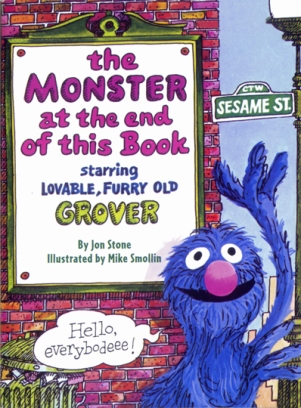
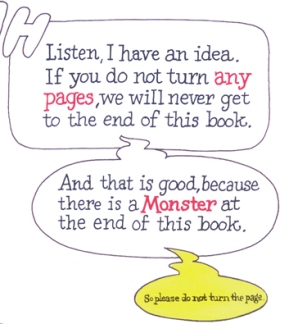
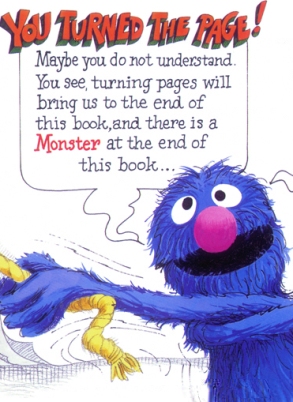
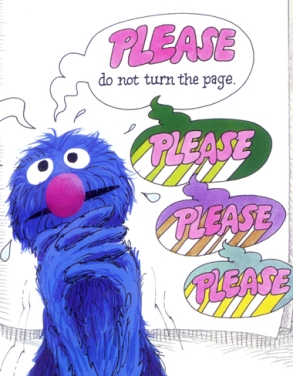
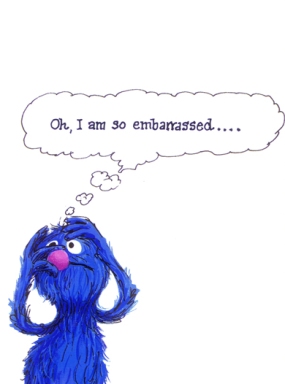
{ 10 comments… read them below or add one }
I LOVE this book! Love it! I read this to my little sister when she was a kid, and had to get it to read to my own kids when they came along. Thanks for the reminder about it. Now I’ll have to get it for her new little one.
I had some memory of this book and went searching for it when my son was two. He liked it at first, but after one reading that was too fun for me (I read it too zealously, which ended up scaring him), he won’t let me read it. I ask every few months to let me read it, but he ends up saying he’s afraid of monsters (even though he knows it’s only Grover). The newest excuse is that we should listen to Grover and not turn any more pages. Some day… some day… he’ll understand.
My 5.5yo loves the other books you recommended in the ‘if you liked’ section so I think we’ll request this one soon (after six weeks, we finally had to send ‘Press Here’ back to the library).
I’d remember reading TMATEOTB pre-kids and finding it funny, but never considered checking it out later because I generally avoid all of the tie-ins due to crappy writing. And I detest all of the marketing crap everywhere, even Elmo on Organic Apple Juice for goodness sake.
Wow, someone who loves this book as much as I do! This was my favorite book when I was a kid, and a few years back my fiance bought me a brand-new copy of it as a gift. I can remember my sister reading it to me when I was little and how she’d try to imitate Grover’s voice.
Ah, youth.
there’s also an app of this book! my nephew, and a lot of the kids I babysit love it! you get to pull out the nails, untie the rope knots, etc. and the font is the same. it’s kind of steep at $3.99, but I got it as a free download at starbucks… and bought the second one as a result.
My dad used to read me this book growing up! Every time we turned the page, he did his best Grover-scared-out-of-his-mind impression. I still remember the shouts of, “OH NO!!!!!!!!!” And I would laugh so hard every time, while wondering if maybe there really was something sinister at the end of the book this time, even though I had read it with him before and knew it would just be Grover. It was such an adventure! I should read it with him again just for fun.
Love this post. However, your comment about Sesame Street, or Grover, being “corporate-owned commercial property” made me wonder what you are talking about. Sesame Street is the creation of the Sesame Workship, formerly the Children’s Television Workship. From the Sesame Workshop website (Sesameworkship.org), “Sesame Workshop is the nonprofit educational organization behind Sesame Street and so much more.” So, I’m a little confused. What did you mean by that statement?
That’s a very fair point. And I’ve changed the text in the article to adjust that mistake.
What I meant to say was “why would I pick a book that was based on a TV show” and the “corporate-owned commercial property” thing came more from my prejudices against other TV show-based books like Dora and Spongebob books. And, despite their nonprofit status, Sesame Street is a pretty big money-generating entity, so I still think there are shades of the corporate touch to many of the more recent Sesame Street products. But, as you can see from several of my past blog posts, I’m a HUGE Sesame Street fan and a big fan of the Children’s Television Workshop, so I didn’t mean to misstate or wrongly portray their status as a nonprofit. I think they’re an amazing organization. Hope you think my changes and this clarification is fair.
Ok, understood. Sorry if it seemed nitpicky – it just jumped out at me in what I thought was an otherwise wonderful article. Thanks for writing it – it brings deeper insight to a book I loved as a kid.
Nah, wasn’t nitpicky. I’d completely misstated something. I’m glad to make the correction/clarification.
And thanks for reading it!
{ 1 trackback }